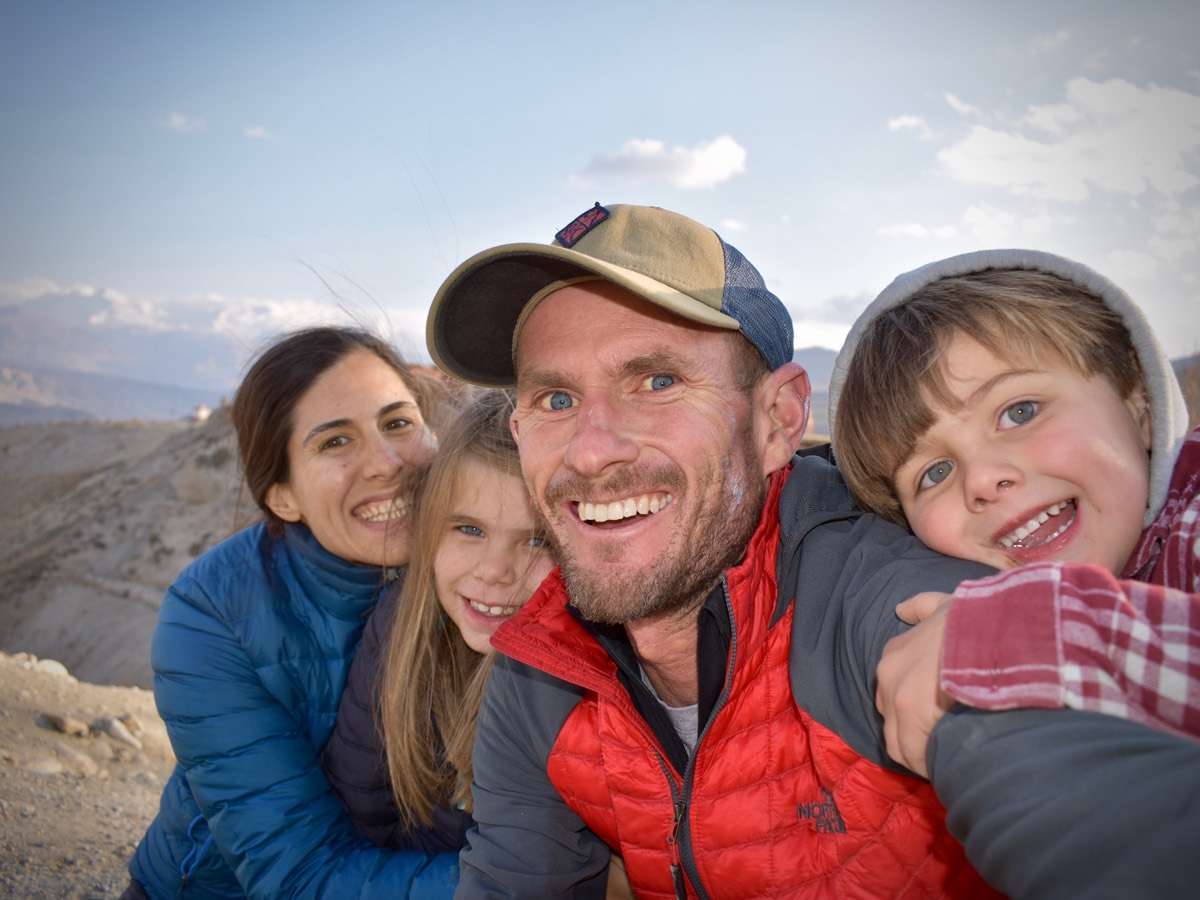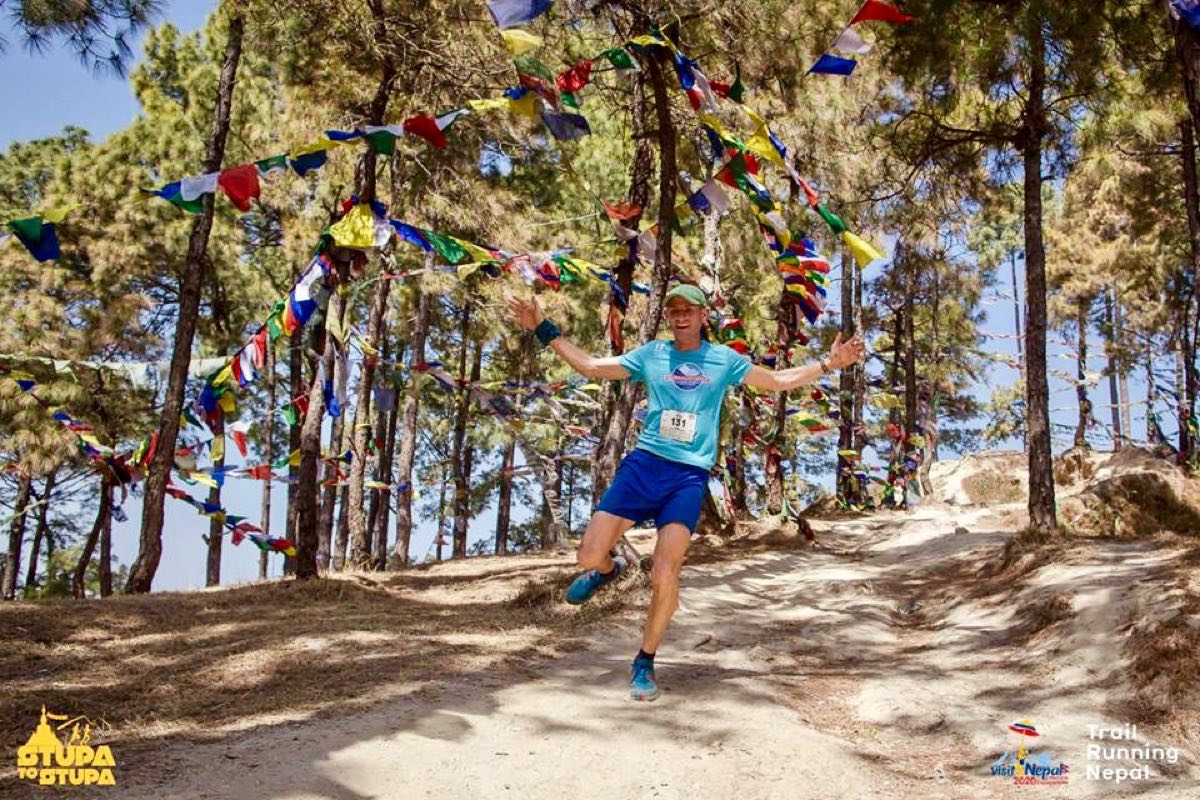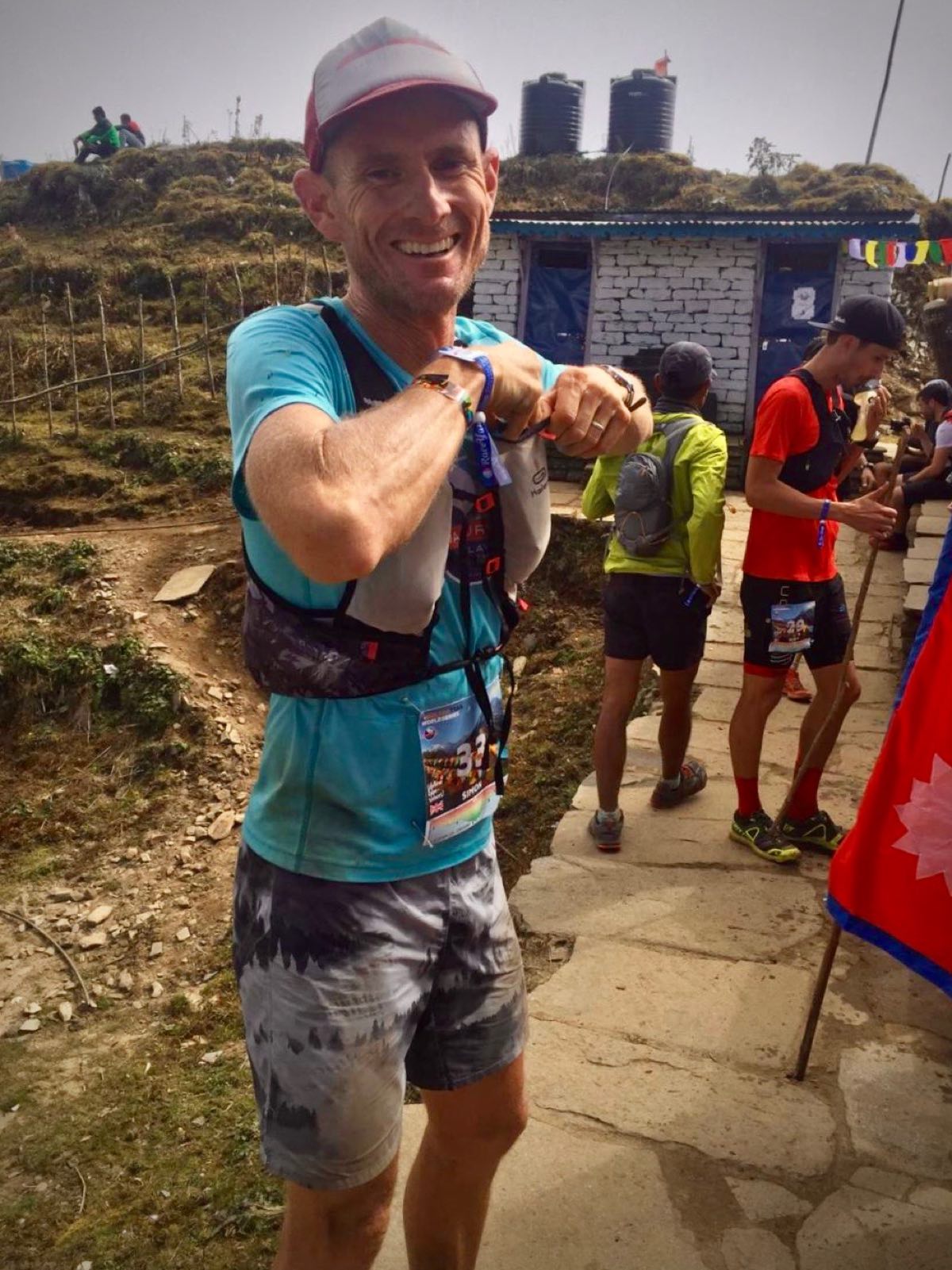[Editor’s Note: It’s an honor to host the story of today’s guest writer, ultrarunner Simon Castro-Wooldridge, about running–and living–with leukemia.]
I have lived in Nepal for the past four years with my family. We arrived just after the earthquake in 2015 and I have managed projects reconstructing health facilities. Previously, I had the incredible opportunity to work for a decade managing landmine-clearance programs in Iraq, Sudan, Somalia, and Colombia.
My first attempt at a trail race, a hilly 35-kilometer event among the Himalayan foothills that ring Kathmandu, the capital city of Nepal, was pretty difficult. I was overtaken by a man in his sixties who was walking, and ended that day lying in the fetal position at a Saint Patrick’s Day picnic, groaning. That was April of 2016, when I was aged 38. Four months later, I was struggling to keep up with friends on a morning jog, and had to walk home. It was this blow that sent me to the doctor, hoping that perhaps I had worms in my gut which would help explain such dire performances and feelings.

Simon Castro-Wooldridge with his wife Vivian and children Paloma and Noa in Mustang, Nepal. All photos courtesy of Simon Castro-Wooldridge.
A wonderful doctor in Kathmandu, where I live with my family, ordered a battery of tests and the same day managed to piece together a disparate range of symptoms. I had a very high white blood cell count (300,000 as opposed to the normal range of 4,000 to 11,000), random and colorful bruising on my legs (I thought that it was just from playing football with the kids), an enlarged spleen, some yellowing around the eyes, small cuts that had not healed, and I was thinner than usual. Her diagnosis was chronic myeloid leukemia (CML, a type of blood cancer). She could not immediately tell what stage the cancer was in–chronic, accelerated, or the worryingly-called ‘blast crisis’–but the next day at the main hospital in Kathmandu one of the pathologists was able to tell me that it had been discovered relatively early and was still in the first phase. I traveled back to the U.K., where I am from, to start treatment.
CML is a relatively rare type of leukemia (approximately 5,000 new cases are diagnosed in the U.S. each year), but thanks to the persistence of medical researchers in the late 1990s, there are drugs that can very effectively manage the condition, which previously had a poor prognosis and usually required a bone-marrow transplant. The drugs, essentially a type of chemotherapy taken daily in a pill, shut off the overproduction of immature white blood cells that is triggered by a mutation of two chromosomes. No one knows why the mutation suddenly occurs, although there is research that links CML to radiation exposure.
I started taking a medicine called Nilotinib, which comes in a box with a pretty long list of potential side effects. Early on, I experienced a lot of fatigue and muscle pain (doesn’t every ultrarunner?), although that has lessened considerably over time. As the drugs can be quite toxic for the liver, I stopped drinking alcohol. Due to a process called bioavailability, the medicine has to be taken strictly 12 hours apart, with a three-hour fasting period around each dose to ensure that there are no calories in the body that could speed up the absorption rate. After a couple of weeks of feeling quite wiped out, I wanted to run again and started out on gentle woodland trails. I returned to Nepal after two months, started back at work, and kept running.
The trail running scene in Nepal is fantastic. There is a monthly race in the Kathmandu Valley that draws kids and adults of all ages, shapes, and nationalities, along with the best runners in Nepal. On top of that there is the annual Annapurna 100k race, the 100-mile Kathmandu Valley Rim route, and a 55km race that knits together a loop taking in five Buddhist stupas that ring Kathmandu. I threw myself into all of this racing with relish, loving the hard uphills and the technical, steep singletrack descents. Best of all was watching at the end as my wife Vivian and our kids Noa and Paloma also finished the races, mud-splattered and grinning.
Although I had run a couple of sub-three-hour marathons in my twenties, in 2016 I was still very much a novice on the trails, and had no idea that trail running was such a growing global phenomenon. In 2017 I ran the Annapurna 100k, my first long race, and managed to come fifth. One of the challenging aspects of running with CML is managing the fasting periods during training and racing. After three hours of only consuming water, my performance deteriorates and I need to eat a big meal. Making sure I have the supplies to do this requires a bit of planning. I ran the Annapurna 100k race again in 2018 and finished first, and then headed to the inaugural Oman by UTMB, 137k with a lot of elevation gain. This was my longest race, but delightfully I arrived at the midway aid station (a buffet at a five-star hotel with real coffee!) just as I finished a fasting period, which kept me on track to finish 10th and on the podium for the over-40 men, grinning away next to Jason Schlarb (who finished about five hours before me, a reality check!).
For about a year after my diagnosis, wanting to overcome leukemia and be as strong and healthy as possible motivated me to train and race hard. Every three months, I had blood tests to determine how much leukemia remained in my blood. The results were fine, generally showing a downward trend, but my response was not as optimal as some patients. My Nilotinib dosage was increased to the maximum, and my liver toxicities were carefully monitored to make sure that the side effects were tolerable and not doing irreparable long-term harm. Finally, in the summer of 2019, I reached a point called a ‘major molecular response’ where there are less than 0.1% of leukemic cells in the blood. (I had 155% at diagnosis.) So, what better way to celebrate than by running the UTMB! Thanks to some good race results, I managed to qualify for an elite bib and stand at the front at the start, surrounded by real legends of the sport. Once the stirring music stopped, they all blasted off at an amazing pace while I set off at a distinctly non-elite jog!
Interestingly, during the UTMB I didn’t even once think about having leukemia. I thought about how best to manage the nine hours during the 32 hours of racing when I would not be able to consume any calories (and I found out the hard way that bread and cheese just does not bring you back from a deep bonk, whatever the volume), but I never thought about the reason why I have to take the medicine. I have never wanted any pity or sympathy, and my family has been amazing and keeps pushing me to challenge myself even further. My fasting for a few hours a day and eating and taking pills according to a very fixed timetable have just become absorbed into the rhythms of our life. Initial shock quite quickly gives way to acceptance.
It is a real privilege to be able to run in Nepal among the Himalayas. I never run with a watch or music because there is always something to look at or think about that keeps every run fresh and interesting. My morning run takes in Hindu temples, Buddhist stupas, rice-paddy fields, and alleyways with ancient houses. Longer runs climb up to the rim around the Kathmandu Valley, where the city rapidly gives way to rural villages and forests. Often I pass villagers and porters carrying enormous loads on their backs. While we get to play in the mountains, life remains hard for many in Nepal. This environment gives a great sense of perspective, and is a good reminder that the few small challenges that I face living with leukemia are really very manageable.
This past weekend I ran the Annapurna Trail Marathon race, the finale of the 2019 Golden Trail Series. A bunch of the top runners from around the world and Nepal all lined up at the start in a small village surrounded by Himalayan peaks. We headed straight up to 3,700 meters before barreling down a long ridgeline descent. Kilian Jornet won handily. It is unfathomable how fast he can fly up and down steep mountains. I realized that I still haven’t figured out how best to manage the fasting periods. I got dehydrated and pretty hungry early on during the race but managed to grind out a solid 25th-place finish. It was my last effort in Nepal before our family moves to the Philippines. I took the time to look around at the awesome scenery and the highlight of my day was watching my wife and friends finish their races looking strong and happy. While I don’t think about having leukemia very often now, I do think that it does drive me to want to race harder, and to take more pleasure in every moment out on the trails and with my family.
Call for Comments (from Meghan)
Are you also a runner who lives and runs with a major illness? Leave a comment to share your story about how running helps you deal with it physically, mentally, or both.


